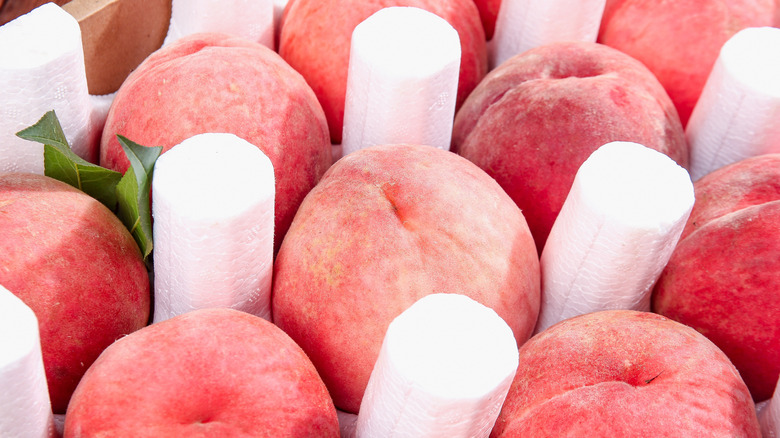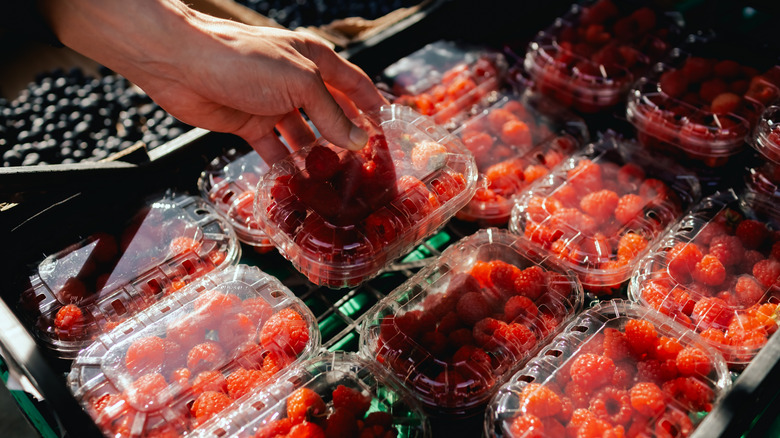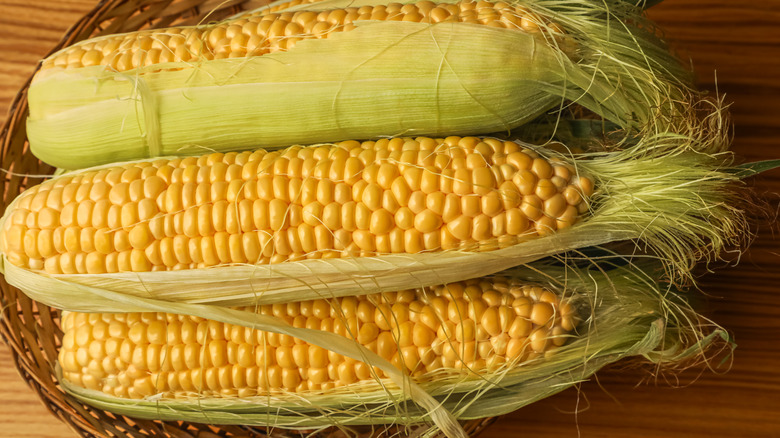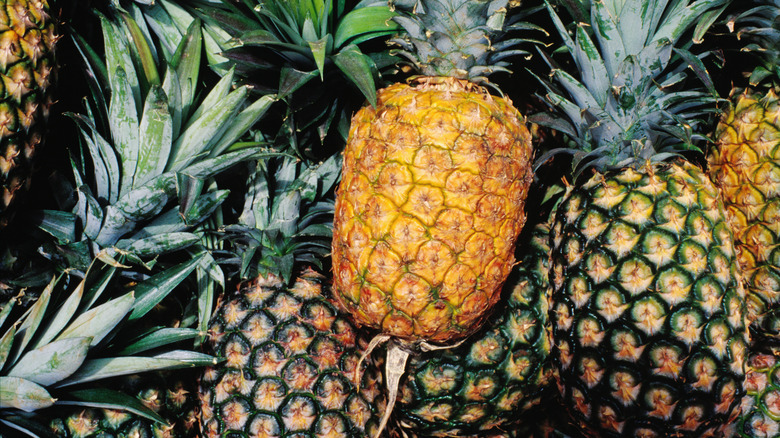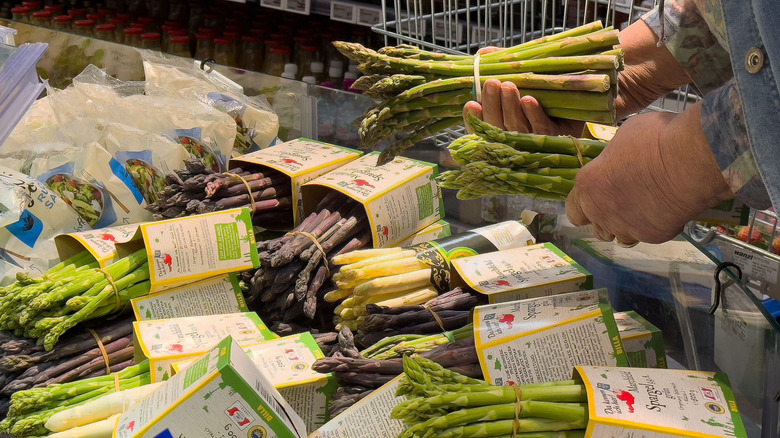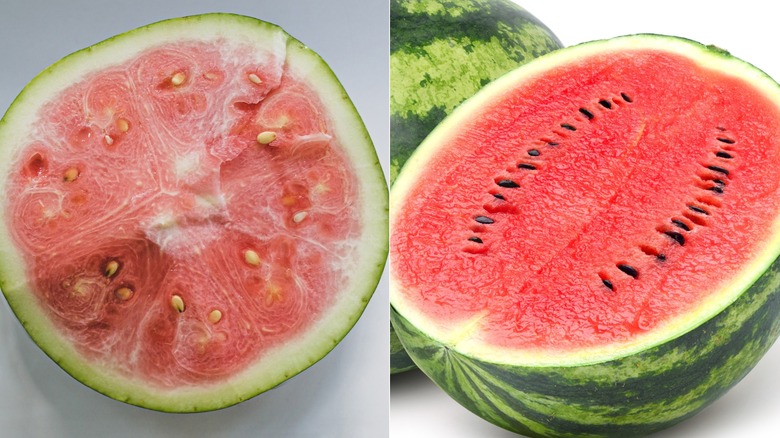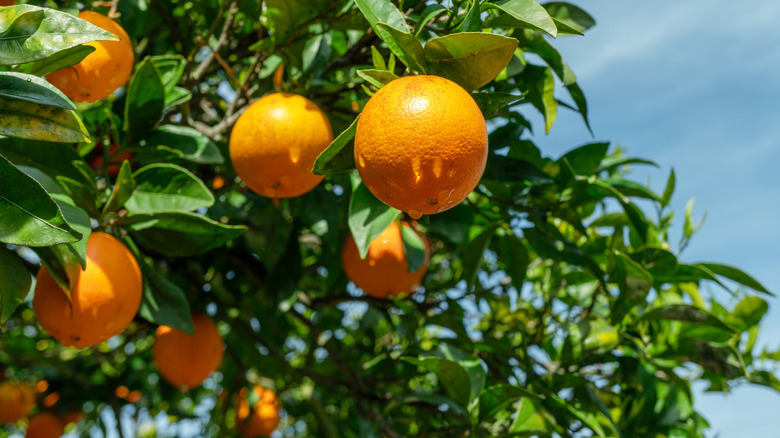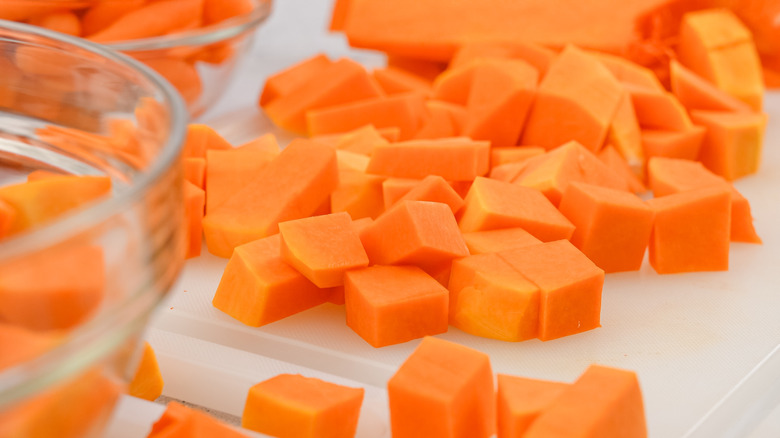13 Fruits And Veggies To Avoid At Grocery Stores When They're Out Of Season
Fruits and vegetables that stay on the vine or tree longer have more nutrients and a better taste, texture, and color. But not everyone lives near a farm or has their own garden, leaving them to rely on what's available at their local grocery store, most of which has traveled pretty far to get there. Ripe fruit is often too fragile to handle a long journey, so it's often harvested prematurely and then artificially ripened.
The natural ripening process typically occurs from the inside out, as ethylene gas permeates from the center out to the skin. Starch converts to sugar, flesh softens, and an appealing aroma develops. Artificial ripening uses gases and chemical dips that work from the outside in, so that the ripening is only skin deep. The fruit is the right color, but the flavor has been sacrificed. When you are expecting a sweet and juicy bite of fruit or a crunchy and flavorful vegetable, it's all the more disappointing to take a bite that's hard and flavorless.
Some fruits and veggies found in your store's produce section are consistently flavorful year-round, but others can be a (literal) bitter disappointment when not in peak season. Here are 13 we recommend avoiding when they're out of season.
1. Tomatoes
There's no other fruit or vegetable that quite exemplifies the stark contrast between in-season and out-of-season taste like tomatoes. Most people just give up on eating tomatoes during the winter because the pale, hard, mealy ones in the grocery store don't even seem worth it. Late summer tomatoes are so flavorful and juicy that settling for anything less is a huge disappointment.
When tomatoes aren't in season locally, they have to be shipped from places where growing conditions are ideal, which is usually a significant distance away. However, the fruit must be picked before it's ripe to be able to withstand the journey. The natural ripening process of a tomato produces a strong aroma, which amplifies the flavor as you eat it. In-season tomatoes can be umami-rich, sweet, or tart, while an off-season tomato is usually bland and pale.
The most flavorful tomatoes are heirloom varieties picked at the peak of ripeness and eaten within a few days. Even during peak season, most of the tomatoes you find in the store have been bred for durability and visual appeal rather than taste. Growers know these varieties are easier to transport long distances and are the uniform color customers expect, but the sacrifice for those traits is less flavor.
2. Peaches and other stone fruits
Peaches are available almost year-round due to the staggered growing seasons in the states that produce the most peaches. All but seven states grow the stone fruit, so they're typically in stores from June to September, as early as April in Florida, as late as October in California, and into November in Colorado. Otherwise, the fruit is typically harvested prematurely, like other delicate stone fruits, so that it's firm enough to be shipped without damage.
Peaches continue to ripen during transit, but they do not develop the same sweet taste as sun-kissed peaches left longer on the tree. You can try to ripen hard peaches, but it's worth waiting until peak season for the juiciest and most flavorful fruit. Ripe peaches should have a sweet fragrance and deep golden-colored skin with small wrinkles near the stem. A simple squeeze test at the store will help determine a good candidate.
Other stone fruits — apricots, plums, etc. — are in season mid-spring to mid-summer and taste best when they are eaten soon after being picked, as the ripening process stops once they are removed from the tree. They will continue to soften but will not get any sweeter. Learn how to make the most of stone fruit season so you can enjoy the flavors throughout the year.
3. Cantaloupe
Buying a cantaloupe at the store when it's out of season is a good way to have a bad experience. Cantaloupes grown during cooler months will be pale, hard, and flavorless. That's because the secret to growing the sweetest-tasting melons is sunlight. The amount of sun exposure a melon has during its life cycle affects the amount of sugar it develops. For a fruit that is 90% water, flavor development is imperative, and one of the many reasons why you should avoid buying unripe cantaloupe, which won't become any sweeter sitting on your kitchen counter. In contrast, ripe cantaloupes are heavy with juice and have a sweet, floral smell at the stem.
Seventy-five percent of the nation's melons are grown in California, but Arizona, Texas, Georgia, and Florida also have the ideal warm and dry conditions for growing sweet melons. There's a short window of time for eating a ripe cantaloupe, because within a few days of harvest, the melon becomes softer and develops an in-your-face, rancidly sweet stench. Another way to ruin a good cantaloupe is by eating the overpriced pre-cut fruit you find in the produce section.
4. Berries
Raspberries and blackberries are at their sweet peak in summer, which is when you should buy them if you want the freshest, most flavorful, and most nutritious fruits. Buy them directly from a farmer's market if you can, because it is nearly impossible to get fully ripened berries at a grocery store.
Berries are fragile and have one of the shortest shelf lives of any fruit. They can be gassed to prevent decay, but it gives raspberries a funny taste. Many berry growers harvest their crop before the fruits are fully ripe to reduce potential damage during transit. Plucked from their plants prematurely, these berries miss out on the additional sugars that would continue to develop their flavor, texture, size, and color. For example, ripe blackberries are a dull black color; beware of shiny blackberries, a sign they were picked early. Meanwhile, fully-ripened raspberries have a deep red color, whereas unripe berries are more pink.
Ripe berries should be eaten or refrigerated as soon as possible because they become soft after a few hours on the counter and mushy after a few days in the fridge. If this happens, don't throw them out — they are one of the best overripe fruits to use for making fruit leather.
5. Corn
Interestingly, corn tastes better if harvested before it is fully ripened, when it is tender, juicy, and at its apex of sweetness. However, once cut from the stalk, the sugars begin to convert into starch, so the sooner it's eaten (ideally within one to two days), the better it tastes.
Corn season runs from May to September, and it should be easy to access freshly harvested corn because it grows in all 50 states. You can pick out the best corn by using a hands-on approach. There are also visual clues to its freshness; the corn silk should be a light tan color, rather than dark or slimy. Meanwhile, the husk should be bright green and fitted snugly around the cob.
If it's not corn season and you are craving that sweet taste, frozen or canned corn is a great alternative. The corn is processed within hours of harvesting, preserving it at its peak sweetness and vitamin content.
6. Pineapple
If you want a fully ripened, succulent sweet pineapple, you probably won't find it at your grocery store. Ninety percent of pineapples consumed in the U.S. were grown in Costa Rica. The country's pineapple harvest never ends, with some growers planting new crops 365 days a year, but the peak time when the fruits are sweetest is generally considered to be March through July.
Pineapples that are shipped by sea are picked early, sanitized, coated with wax, and packed in refrigerated containers for the multi-week journey. Your best bet is to buy a premium pineapple, picked at its pinnacle and shipped by air freight within 48 hours. These are sold under names such as Jet Fresh, Maui Gold, Honeyglow, and Precious Honeyglow (a single-serve pineapple).
There are many methods claiming to identify a ripe pineapple, and though some have no merit (I'm looking at you, leaf-pullers!), others are a sure thing. Sniffing your pineapple for a sweet smell is a reliable indicator of a fully ripened fruit, but judging it by its skin color is not. Some varieties turn a golden yellow, but others remain partially or completely green even when fully ripe. If you get stuck with an underripened fruit, try this storage trick that makes pineapples effortlessly sweeter.
7. Asparagus
Asparagus can usually be found in stores year-round, but during its peak season — May to June — it is more flavorful, sweet, and tender. But what makes the season something to look forward to is the availability of more varieties of asparagus. It's the ideal time to be adventurous and try sweet and nutty purple asparagus or tender white asparagus — just make sure you're not making any of these mistakes with this delicate vegetable.
Asparagus stalks should be treated like flowers and stored upright in water in your refrigerator. Ideally, you should eat asparagus as soon as possible after it is harvested because it becomes more bitter the longer it is stored. When choosing a bunch, look for smooth stalks and a tight tip and avoid those with cracked or dry ends. You can also check the quality by rubbing the stalks together; if they squeak, they are fresh.
8. Watermelon
Eating out-of-season watermelon is depressing, and could be likened to eating wet Styrofoam. Watermelons stop ripening the moment they are cut from the vine, so eating them at their peak makes all the difference in taste and texture. In-season watermelon is a crisp, juicy, sweet treat that is the backbone of summer BBQs.
To avoid the disappointment of pale, bland, and mushy melon, find out when watermelon season is in your area. Then try some reliable methods for finding a ripe and juicy sweet watermelon. Look for a white or yellow patch, which is evidence that the melon stayed on the vine longer, developing a sweeter flavor. Pick up your specimen — it should feel heavy for its size and have a firm but not rigid rind.
And then there is the thumping technique. Using a flat hand, a few fingers, or a fist, thump various spots on the melon to get an accurate acoustic sample. If the sound is dull or flat, it is either underripe or overripe, so move on to another melon. Instead, the sound should be deep with a slight echo.
9. Citrus
While wintertime is when we tend to crave warm soups and hearty meals, it is also the season that highlights sweet and vibrantly tart citrus fruits. Oranges are in stock year-round, but there is a peak season when the fruit tastes best, contains the most nutrients, and has the longest shelf life.
The peak season depends on which type of citrus you want. The juiciest and sweetest navel and blood oranges are available from about December to early spring. Clementines and tangerines are in season from October to January. For juicing oranges, wait for Valencias to peak between March and September.
Florida, California, and Arizona have ideal climates for an extended citrus growing season because the cooler night temperatures slow the ripening process. The longer the fruit remains on the tree, the more time it has to develop its sugars and a sweet, bright flavor.
10. Strawberries
If you've never tasted one fresh from the vine, you've never truly tasted a strawberry. The fruit has its most pronounced flavor when it's sun-kissed and warm right off the vine. Cold temperatures suppress the fragrance, making it less flavorful. Warm temperatures allow the strawberry's scent to create a strong multi-sensory flavor. If you keep them refrigerated, allow your strawberries to come to room temperature before eating them.
The best chance for finding a deliciously flavorful, richly colored strawberry is during the spring and summer in most areas, though California's strawberry season lasts nine months. Accessing in-season strawberries is challenging if they must travel a long distance to your store, because they are one of the most perishable fruits.
Picked at the peak of ripeness, strawberries must be quickly refrigerated to slow the fruit's rapid ripening cycle. Even an hour delay between picking and cooling can increase the harvest's chances of over-ripening during transit. Once harvested, the berries' sugars begin to convert to starch, and the sweetness is gradually lost, so eat them as soon as possible. If you're lucky enough to get them directly from a grower, consider the various ways to prevent your fruit from going to waste.
11. Spinach
Spinach is one of the O.G. superfoods, touting high levels of vitamin K, A, and C, magnesium, calcium, iron, and antioxidants. However, if you aren't eating freshly picked spinach from a local producer, you aren't getting the nutritional value you think you are. Spinach doesn't hold onto its vitamins for long, especially after a few days in a warm shipping container in transit to your grocery store. Even if it is refrigerated, this leafy green can lose most of its nutrients within seven days.
Spinach flourishes in cooler temperatures, and while it's available year-round in the produce section, the freshest and most nutrient-rich plants are grown during two seasons: March to May and September to October. Spinach grown in warmer weather tends to taste more bitter.
If you can't find freshly harvested spinach or can't eat it within a few days, buy it frozen instead. Leafy greens like spinach are one of the best frozen foods to eat because they are flash frozen within hours of harvest, which preserves nutrients at their peak. So, the box of frozen spinach in the freezer section of your store has four times more iron, vitamin C, and calcium than the leafy bunches you'll find in the fresh produce section.
12. Rhubarb
Eating rhubarb in its peak season is not only about getting the most flavor out of this sweet-and-sour vegetable, but also about reducing toxin levels. Rhubarb is a vibrant, uniquely tart, early-season vegetable that you can do a lot with. It is at its peak of taste beginning in April and continuing through June. Rhubarb is commonly grown in home gardens, where it can be harvested and eaten immediately. Most grocery stores will have some in stock during rhubarb season, though there may not be much. For the best rhubarb, choose a crisp stalk that is at least a foot long and either deep red or dark green. Large leaves are a sign of a juicy plant, but that is also where a high level of oxalic acid is found, which is why the leaves should never be eaten.
When rhubarb plants are young, harvested late in the season, or have been exposed to frost, the oxalic acid is more likely to move into the stalks. An unappealing bitter taste that signals high levels of oxalate should warn you away from plants that have become tainted and could, at minimum, cause nausea, vomiting, and diarrhea, or, worst case scenario, affect respiratory or kidney function. Other warning signs are leaves that are browning or wilting, and stems with cracks or soft spots.
13. Butternut squash
Butternut squash soup is as much a part of autumn as colored leaves and fuzzy jackets, because that's when the winter squash is in peak season, though it can extend into December in warmer states. In-season butternut squash can be the star in both sweet and savory dishes, from butternut squash pavlova to spicy, roasted squash sandwiches.
For the best flavor, choose a squash with a beige-colored shell, no soft spots, and one that feels heavy for its size. While it can be found in the store at other times in the year, it won't have the same deep, sweet taste and firm texture. Due to its characteristically long shelf life, the butternut squash you find in the store in the spring or summer could be several months old.
Squash is more flavorful and nutritious when grown in its regular season, so you'd be wise to stock up then. It should stay good for a few months if stored in a dry, cool, well-ventilated area. Just be sure to check for signs that it has gone bad before eating it. If you want to extend your supply to last you through the whole year, try freezing it in raw cubes or as a cooked puree.


